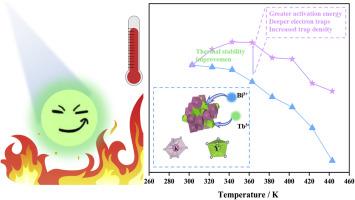Enhanced luminescence and negative thermal quenching in Bi3+/Tb3+ Co-doped KYF4 green phosphor
IF 3.5
3区 化学
Q2 CHEMISTRY, INORGANIC & NUCLEAR
引用次数: 0
Abstract
Despite the broad application of phosphors in lighting technologies, they still face considerable limitations in thermal stability. A novel green-emitting KYF4:Tb3+,Bi3+ phosphor was successfully synthesised via a hydrothermal approach, exhibiting superior photoluminescence performance and enhanced thermal stability. The material achieved an absolute photoluminescence quantum yield of 59.74 %. The incorporation of Bi3+ ions enabled efficient energy transfer to Tb3+ centres, resulting in a 1.5-fold increase in green emission compared to the Tb3+-only doped sample. Thermoluminescence and activation energy analyses revealed that Bi3+/Tb3+ co-doping introduced deeper trap states, increased trap concentration, and a higher thermal activation energy (Ea = 0.47 eV), all contributing to improved thermal stability. Notably, the phosphor maintained nearly constant emission intensity at temperatures up to 443 K. Furthermore, prototype white light-emitting diodes fabricated using the synthesised phosphor exhibited high-quality white light emission under a 10 mA driving current, characterised by an excellent correlated colour temperature and a suitable colour rendering index for lighting applications. These findings demonstrate that Bi3+ co-doping is an effective strategy for enhancing both luminescence efficiency and thermal stability in rare-earth-based phosphors, offering valuable insights for the development of advanced solid-state optical materials.

Bi3+/Tb3+共掺KYF4绿色荧光粉的发光增强和负热猝灭
尽管荧光粉在照明技术中得到了广泛的应用,但它们在热稳定性方面仍然面临着相当大的限制。通过水热法成功合成了一种新型的绿色荧光KYF4:Tb3+,Bi3+荧光粉,具有优异的光致发光性能和增强的热稳定性。该材料的绝对光致发光量子产率为59.74%。Bi3+离子的掺入使能量有效地转移到Tb3+中心,与仅掺杂Tb3+的样品相比,绿色发射增加了1.5倍。热释光和活化能分析表明,Bi3+/Tb3+共掺杂引入了更深的陷阱态,增加了陷阱浓度,提高了热活化能(Ea = 0.47 eV),这些都有助于提高热稳定性。值得注意的是,荧光粉在高达443 K的温度下几乎保持恒定的发射强度。此外,使用合成荧光粉制造的原型白光发光二极管在10ma驱动电流下表现出高质量的白光发射,其特点是具有优异的相关色温和适合照明应用的显色指数。这些发现表明,Bi3+共掺杂是提高稀土基荧光粉发光效率和热稳定性的有效策略,为开发先进的固态光学材料提供了有价值的见解。
本文章由计算机程序翻译,如有差异,请以英文原文为准。
求助全文
约1分钟内获得全文
求助全文
来源期刊

Journal of Solid State Chemistry
化学-无机化学与核化学
CiteScore
6.00
自引率
9.10%
发文量
848
审稿时长
25 days
期刊介绍:
Covering major developments in the field of solid state chemistry and related areas such as ceramics and amorphous materials, the Journal of Solid State Chemistry features studies of chemical, structural, thermodynamic, electronic, magnetic, and optical properties and processes in solids.
 求助内容:
求助内容: 应助结果提醒方式:
应助结果提醒方式:


